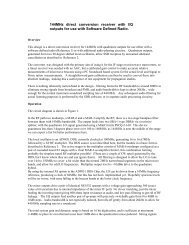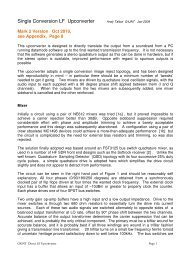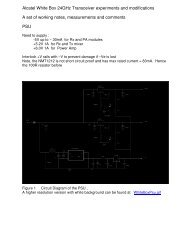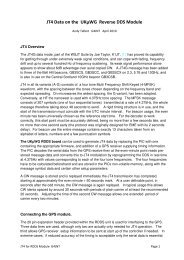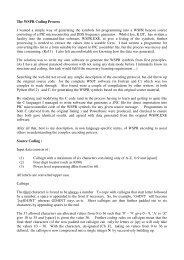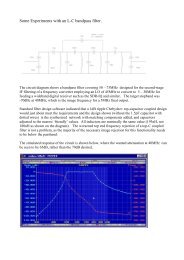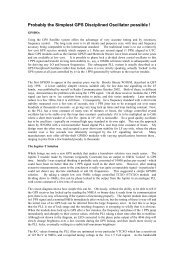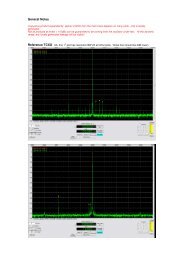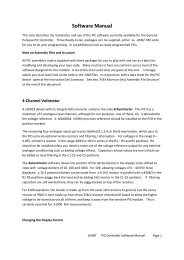NEW GENERATION BEACON DRIVER - G4JNT
NEW GENERATION BEACON DRIVER - G4JNT
NEW GENERATION BEACON DRIVER - G4JNT
You also want an ePaper? Increase the reach of your titles
YUMPU automatically turns print PDFs into web optimized ePapers that Google loves.
Message StructureIn normal usage JT65 relies on automatic timing control, making use of a one minute transmit / one minute receivesequence which has to be replicated in the receiver’s computer. The timing is allowed to be in error by up to four secondslate or one second early when referred to the transmission. The rest of the beacon's timing is based on a thirty secondtime-slot structure which determines the data transmission pattern for the whole beacon sequence. As the JT65transmissions must be aligned with the minute, timeslots must be set and allocated accordingly. Time information sentfrom the GPS receiver is used to derive a number of 30 second time slots, referenced to the hour, and any even number ofup to 16 slots can be programmed with different data formats allocated to each 30s slot. Changes are made by modifyingthe PIC code for the beacon controller. For a typical transmission sequence, JT65 will be allocated to every fourth slot(starting at an even number), to give the one minute + one minute cycle of transmission periods. As a JT65 transmissionperiod lasts 48 seconds it will run into the next 30s time, so this one cannot be allocated to any other mode. The rest of theslots can be allocated to CW, Carrier, BPSK or RTTY as needed. To avoid sequence breaks on the hour, the number ofslots used should ideally be a submultiple of 120, so values of 2,4,6,8,10,12 are the most convenient, corresponding to 1 to6 minute repeat cycles. The number of minutes for the cycle is specified in the setup information.Any CW or RTTY transmission will be of arbitrary length, and the remaining time up to the end of their timeslot isautomatically taken up with plain carrier. If a CW or RTTY data exceeds 30s in length, the data for the following timeslotwill be ignored.Although the second 30 second slot after a JT65 transmission is ignored, it should be defined in the sequence definition.This is because JT65 is not transmitted when the GPS receiver has lost lock. The first time slot allocated to JT65 defaults,instead, to the first CW message and the second time slot is as defined in the setup data. When GPS lock is restored, JT65operation resumes and the second time slot definition is then ignored.As implemented on GB3VHF the sequence programmed is :00:00 JT65 sending the message “GB3VHF JO01DH”00:30 CW message as below (only sent during Invalid GPS)01:00 CW Message “GB3VHF JO01DH” (approx 13 seconds) followed by plain carrier01:30 Phase reversals at one second intervals.Repeated every two minutesAs far as a listener is concerned, starting on the even minute boundary, this appears as :48 seconds of JT65 transmission12 seconds of plain carrier13 seconds of CW Ident17 seconds of plain carrier30 seconds of phase reversals- Sequence repeats---------------------------------------------------------------------------------------------------------------------------DDS and Controller HardwareThe driver unit comprises several modules working together under the control of a single 16F628 PIC microcontroller.The DDS is clocked from a reference input, and a Phase Locked Loop on board the AD9852 multiplies this by aprogrammed value from 4 to 20, for a maximum allowed clock frequency of 300MHz. In this VHF-band beacon driver, areference input of 12.8MHz is multiplied by 16 in the PLL for a 204.8MHz clock. Keeping the clock below the 300MHzmaximum permitted in the AD9852 specification results in a lower power consumption and improves reliability of the DDSchip. The 12.8MHz reference oscillator is derived from a Voltage Controlled, Temperature Compensated CrystalOscillator (VTCXO) which in turn is phase locked to the 10kHz output from a Jupiter TU-60 GPS receiver module.The microcontroller, mounted on the same PCB as the DDS chip, communicates with the GPS receiver in order to read thetime of day (UTC) and the GPS receiver / satellite status information. The 1 Pulse Per Second (1PPS) signal generated bythe GPS receiver is fed to the PIC in order to generate accurate timing – the 1PPS signal is typically accurate to within200ns of UTC. The PIC uses the data from these two signals to accurately set the start and stop times of the variousmodulations transmitted.Page 2


